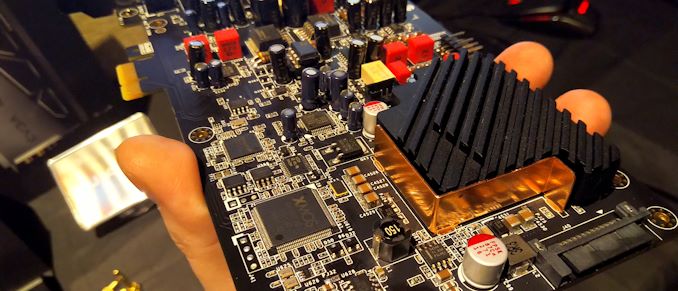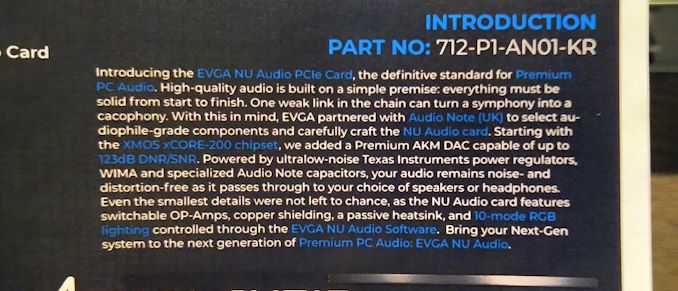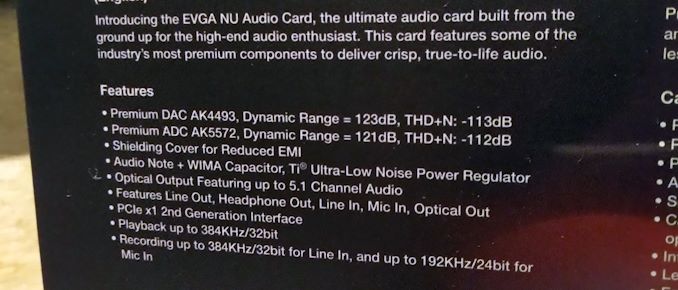EVGA Launches Its First Audio Card, the Nu Audio
by Ian Cutress & Anton Shilov on January 22, 2019 1:00 PM EST- Posted in
- Audio
- EVGA
- Trade Shows
- NU Audio
- CES 2019
- Audio Note

EVGA currently sells a range of products: motherboards, graphics cards, power supplies, cases, and laptops. EVGA has been expanding to other markets for a number of years now, and at CES 2016 we saw the beginnings of a USB audio device due to a collaboration with a professional company called Audio Note. We were impressed at the time, but since then we've not heard much about the project, and had kind of assumed it had been abandoned. But at CES 2019 EVGA introduced the results of the collaboration: its first audio card. This card uses a PCIe to USB controller, making it an internal USB audio product.
EVGA’s Nu Audio card was designed by Audio Note, a UK-based company that develops custom audio solutions. The PCIe 2.0 x1 card implements a PCIe to USB controller to the hardware, and is based on the XMOS xCORE-200 DSP accompanied by Asahi Kasei Microdevices’ (AKM) AK4493 DAC, the AKM AK5572 ADC, and the Cirrus Logic CS5346 ADC. The board uses a silver and gold-plated multilayer PCB with isolated dual ground planes for analogue and digital circuits. Being aimed at users who want a cleaner sound but also better sound support out of their audio outputs, the Nu Audio card uses audio-grade capacitors and resistors that carry Audio Note, Nichicon, WIMA, and Panasonic brands. Besides, it features switchable OP amps as well as a dedicated Maxim amp for headphone volume control.
The Nu Audio card is equipped with two RCA line outs for left and right speakers that can output 384 KHz at 32-bit audio, one output for headphones featuring impedance between 16 and 600 Ohms, an S/PDIF out, a line in supporting 384 KHz at 32-bit audio, and a mic in supporting 192 KHz at 24-bit audio. In addition to traditional analogue and digital outputs, the card supports USB audio class 2.0 enabled by the ASMedia ASM1042 PCIe-to-USB bridge. Meanwhile, to ensure that the board gets enough power, it has a SATA power connector coupled with a multi-stage VRM.
Since EVGA usually targets enthusiasts, its audio card is not only outfitted with a cooling system for heating components, but it is covered by a shroud featuring 10-mode RGB lighting as well as four Audio Reactive Lighting options that match the board’s lighting and audio. The bundled software allows for full EQ tuning, as well as a dynamic response implementation. With the right software, the audio card can support full audiophile formats, such as DSD, and switch between them as required.
EVGA is now currently selling the card, at a price of $249. This is the first in a line of cards, we were told - depending on the feedback of the hardware, the collaboration with Audio Note might extend into a gaming focused design or a more professional audio input/output design.
Related Reading
- EVGA Launches B360 Micro Gaming: Its First Budget Motherboard
- EVGA Releases CLC120 CL11 AIO CPU Cooler: Simple and Affordable
- EVGA Launches SC17 1080 Laptop: Core i7-7820HK, GeForce GTX 1080, TB3
- EVGA Torq X10 Gaming Mouse Review
Source: EVGA
















83 Comments
View All Comments
SirMaster - Tuesday, January 22, 2019 - link
Motherboards and GPUs have digital audio outputs onboard (HDMI).There is no difference in quality between an onboard S/PDIF or HDMI port and one on an audio card. Both their digital outputs are bit-perfect and they send the audio stream to my (far more expensive than an audio card) AVR with a nice quality DAC and nice quality amps in it.
mode_13h - Wednesday, January 23, 2019 - link
The main difference is the multi-channel formats they can support. For whatever reason, the standardized formats supported by Toslink are quite limited. I think it's probably out of copy protection fears that once HDCP came onto the scene, all advancement in home theater moved to HDMI.However, for stereo, toslink is fine. You can easily get 192 kHz 24-bit stereo, AFAIK.
Inteli - Tuesday, January 22, 2019 - link
I'm not quite sure what you mean by "hardware based features"... The only thing I can think of would be a 3D audio implementation, and those post-processing features are sort of hit-or-miss in my experience.A sound card is by no means necessary for using an AV receiver, either. You can do it with onboard audio (like my desktop is) via optical, which has been a thing on motherboards for years at this point, or with a video card over HDMI (which is actually the better solution). In fact, depending on the interface you use to connect your sound card to your 5.1 surround sound system, a video card might work better.
It also sounds like you're used to "USB Audio" meaning "headset" instead of as an input for an actual DAC, which is fairly common nowadays. Every single DAC Schiit Audio makes (which range from $100 to $2400) features a USB audio input.
mode_13h - Tuesday, January 22, 2019 - link
AFAIK, multi-channel optical is limited to 48 kHz @ 5.1.HDMI can support more channels at higher bit-rates and sample-rates. Also, more/newer codecs. The main downside is thicker, shorter cables.
Inteli - Wednesday, January 23, 2019 - link
Optical (or coaxial, both use S/PDIF) can't support uncompressed surround sound. For a digital surround-sound interconnect, HDMI is absolutely superior to optical. *Technically* analog surround could match HDMI, but that's hardly supported anymore anyways.I also don't use surround sound with an optical interconnect. The AV receiver I use over optical is acting as a *very* large headphone/stereo amplifier.
Impulses - Tuesday, March 5, 2019 - link
FWIW, Schiit actually used to sell DACs sans USB and positioned it as an add-on, and their designer still views it as an interior option to AES or even SPIDF even if some of the PR they put out around the latest USB implemention claim they solved most potential issues... I think they're still working on a further refined implementation beyond gen 5, tho that seems to work just as well as coax SPIDF for me.mode_13h - Tuesday, January 22, 2019 - link
Since I could get bit-perfect optical out, I've gone with outboard DACs.I use separates, but here's one I always thought was cute:
http://www.parasound.com/zdac-v2.php
Sttm - Tuesday, January 22, 2019 - link
I have an external one, and I love it. SoundBlaster G6. It has a quality headphone amp, decent sound settings, and most important of all has optical input with Dolby decoding, which works at the same time as my PC audio, so I can play a game on my PC or console while watching something on my TV or monitor and have both audio pumped into my headphones.CaedenV - Tuesday, January 22, 2019 - link
Agreed. I am sure this is some nice hardware, but after moving my audio processing to an external device, it is really hard to imagine going backwards. Do all the processing you want inside the box, but get it out via light pipe, and let your amp do what amps do best to your speakers or headphones. Not a lot of demand for internal cards any more... you would think they would know that?mode_13h - Tuesday, January 22, 2019 - link
IMO, the main use case for sound cards evaporated when people started doing audio processing on GPUs (and perhaps CPU cores with AVX). About 15-20 years ago, some sound card ASICs provided audio effects for games that would be impractical to do, otherwise. Now, if you build a sound card with enough processing power to rival what a GPU can handle, you'd pretty much have to put a GPU in it.BTW, AMD briefly had an embedded Tensilica DSP to offload audio processing, in their GPUs. Now, they have better QoS features to enable using some subset of the main shader cores for it.
https://en.wikipedia.org/wiki/AMD_TrueAudio